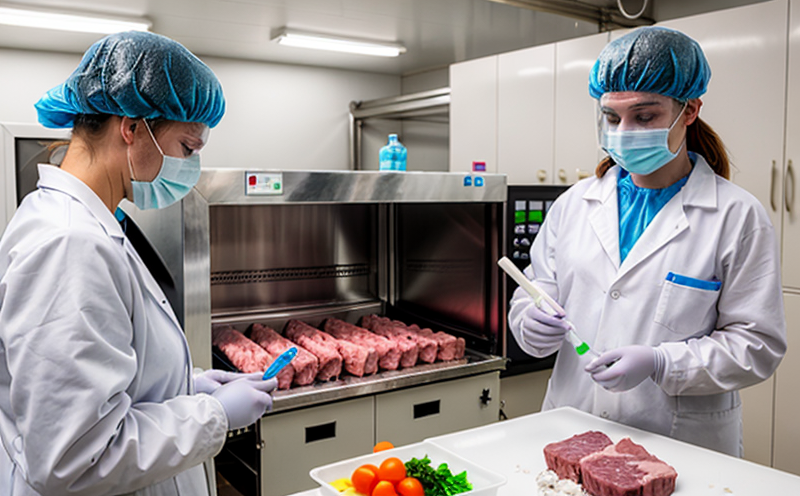ASTM E2720 Biofilm Detection in Dairy and Meat Environments
The ASTM E2720 test method is a critical tool for quality managers, compliance officers, R&D engineers, and procurement teams within the dairy and meat industries. This standard provides a robust framework to detect biofilms on surfaces, which are colonies of microorganisms that adhere strongly to each other and to surfaces in their environment. In dairy and meat processing environments, biofilms can harbor harmful pathogens such as Listeria monocytogenes, Salmonella spp., and E. coli O157:H7. Detecting these biofilms is essential for maintaining food safety standards and ensuring product quality.
The ASTM E2720 test involves several steps: surface preparation, inoculation with a fluorescent-labeled microorganism, incubation period, washing, drying, and finally staining the surface to visualize any biofilm formation. This method allows laboratories to assess the effectiveness of cleaning protocols and determine if residual biofilms are present on surfaces that come into contact with food products.
The primary purpose of ASTM E2720 is to provide a standardized approach for detecting biofilm formation, which can significantly impact food safety by harboring pathogens. By using this test method, laboratories ensure consistency in their biofilm detection processes and contribute to the overall quality control measures within the industry. This standard aligns with international guidelines such as ISO 16865-2:2014 on the prevention of biofilm formation.
The ASTM E2720 protocol is particularly useful for dairy and meat processing facilities where sanitation and hygiene are paramount. Regular biofilm detection helps in identifying areas that require enhanced cleaning protocols, thereby reducing the risk of contamination during production processes. This test method also supports continuous improvement initiatives by providing data-driven insights into sanitation practices.
For quality managers looking to implement ASTM E2720 into their operations, it is essential to understand its technical nuances and how it fits within broader food safety frameworks. By adopting this standard, companies can demonstrate their commitment to maintaining high-quality products and adhering to regulatory requirements.
| Step | Description |
|---|---|
| Surface Preparation | Cleaning the surface to be tested with appropriate detergents and rinsing thoroughly. |
| Inoculation | Applying a fluorescent-labeled microorganism onto the prepared surface. |
| Incubation | Allowing time for biofilm formation under controlled conditions. |
| Washing and Drying | Removing excess moisture to prevent interference with subsequent steps. |
| Dye Staining | Applying a dye to highlight any biofilm present on the surface. |
| Surface Types | Testing Frequency |
|---|---|
| Dairy Processing Equipment | Monthly or as needed based on cleaning efficacy checks. |
| Meat Cutting Surfaces | Daily for high-risk areas, weekly for general surfaces. |
| Refrigeration Units | Quarterly to ensure long-term sanitation integrity. |
Why Choose This Test
The ASTM E2720 biofilm detection method is chosen by laboratories and food processing facilities for its reliability, consistency, and alignment with international standards. By using this test, companies can ensure that their sanitation protocols are effective in preventing the formation of harmful biofilms on critical surfaces.
- Compliance with International Standards: ASTM E2720 aligns with ISO 16865-2:2014 and other international guidelines, ensuring that companies meet global food safety standards.
- Enhanced Safety: Detecting biofilms early helps in preventing the spread of pathogens and reducing the risk of contamination during production processes.
- Data-Driven Decision Making: The results from ASTM E2720 provide actionable insights into sanitation practices, enabling facilities to make informed decisions about their cleaning protocols.
- Consistency Across Locations: Using a standardized test method ensures that biofilm detection is consistent across different locations and facilities within the same organization.
The ASTM E2720 test method is particularly beneficial for quality managers, compliance officers, R&D engineers, and procurement teams who are responsible for maintaining high standards of food safety and product quality. By incorporating this test into their routine procedures, these professionals can ensure that their facilities meet the highest levels of hygiene and sanitation.
Customer Impact and Satisfaction
The ASTM E2720 biofilm detection method has a significant positive impact on both customers and the industry as a whole. By ensuring that biofilms are detected and addressed, companies can maintain consumer trust in their products. This standard helps to reduce recalls and legal disputes associated with foodborne illnesses.
Customers benefit from products that are made under strict hygiene standards, which enhances brand reputation and customer loyalty. For the industry, adherence to ASTM E2720 demonstrates a commitment to quality and safety, fostering trust among consumers and regulatory bodies.
The use of this test method also contributes to long-term sustainability by preventing contamination and ensuring product integrity throughout the supply chain. This aligns with broader corporate social responsibility initiatives aimed at improving food safety and reducing environmental impact.
Use Cases and Application Examples
- Dairy Processing Equipment: Regular testing of pasteurizers, homogenizers, and other equipment used in dairy production to detect biofilm formation.
- Meat Cutting Surfaces: Daily testing of cutting blocks and other surfaces that come into direct contact with raw meat products.
- Refrigeration Units: Quarterly testing of refrigerators and freezers to ensure they remain free from harmful biofilms.
| Use Case | Description |
|---|---|
| Dairy Product Contamination Prevention | Testing milk tanks and pipelines for biofilm formation to prevent contamination of dairy products. |
| Meat Safety Assurance | Inspecting meat cutting areas for biofilms that could harbor pathogens like Listeria monocytogenes. |
| Sanitation Protocol Validation | Evaluating the effectiveness of cleaning protocols in dairy and meat processing plants. |
These use cases highlight the versatility and importance of ASTM E2720 biofilm detection in maintaining food safety and quality across various stages of production. By incorporating this test into their routine procedures, facilities can ensure that they are meeting stringent hygiene standards and minimizing the risk of contamination.





